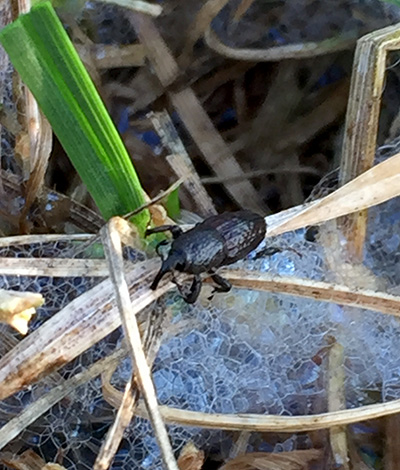Turfgrass pests: Sod webworms, bluegrass billbugs and grubs on the horizon
Insect damage from sod webworms, bluegrass billbugs or grubs may be the reason some parts of your lawn didn’t green-up after recent rains.

In the last couple weeks, abundant rainfall in many areas of Michigan has resulted in previously dry, dormant turf to green-up and resume growth. As the turf resumed growth, there have been many areas where it didn’t green-up, leaving homeowners and turf managers to wonder what might be amiss. Could it be damage from insects, tracking damage from mowing, high temperatures and drought stress, or diseases that caused the damage? The answer is yes to some or all of the above. In some cases, it may be difficult to determine exactly what caused the damage, and it may simply be time to move on and plan a recovery strategy that may require reestablishing lawns. In other cases, it can be critical to determine the causal agent in order to determine a plan of action moving forward.
Sod webworms and bluegrass billbugs
Recently, I’ve noticed numerous sod webworm moths flying around my lawn. From my own experience, you may notice some moths kicking up when walking through the lawn, but once you start mowing, the aerial circus begins. When mowing my own lawn, I’ve seen quite the display of barn swallows circling, diving and feasting on the moths as they take flight. The moths aren’t actually the ones doing the damage, it’s the larvae from the eggs they lay. The damage looks much like heat or drought stress. The turf is thinned and didn't green-up once the rains returned.
Despite the visual cue of moths flying, correctly diagnosing pests prior to pesticide applications is a key aspect of integrated pest management, and correctly identifying sod webworm damage is no exception. You can bring webworm larvae to the surface by pouring a 3-gallon bucket of water with 1 ounce of dishwash soap over the infested area. Wait 3 or 4 minutes for the ivory-colored caterpillars to appear.
I conducted the soap test and quickly realized it was not webworm that might be doing the damage, as I discovered about five to 10 adult bluegrass billbugs per square foot scurrying to the surface. The adult beetles are not doing damage, it’s the prior life stage of the larvae that does the damage.

Bluegrass billbug adult.
Basically, it’s too late this year to do anything and an insecticide application is not necessary. Treatment next summer may be warranted if the damage is extensive. For now, the best strategy is to make a fertilizer application to help the remaining turf plants recover and fill the voids. Spot reseeding may be necessary.
Grubs
With the dry conditions across much of the state in July, it is possible it will be a great year for European chafer grub damage, as they especially like laying their eggs in dry turf. Grubs will be fairly easy to see by Labor Day (Sept. 5, 2016). Sample by digging up a square foot of turf and go through the roots and soil. They will appear as 0.25-to-0.375-inch, C-shaped grubs at that time.
When wilting or patches of dead turf appear in non-irrigated turf where there are more than five grubs per square foot sample, apply Dylox or Sevin at the grub rate to prevent further damage and spring damage in 2017. If your soil pH is 7.8 or higher, repeat the application in three days because Dylox and Sevin degrade rapidly in high pH soils.
European chafer damage may appear this fall, but will especially be noticeable next spring if patches of lawn do not green-up in April. For additional information on grub control products, please see “How to choose and when to apply grub control products for your lawn” by Michigan State University Extension.
Dr. Frank’s work is funded in part by MSU’s AgBioResearch.



 Print
Print Email
Email




